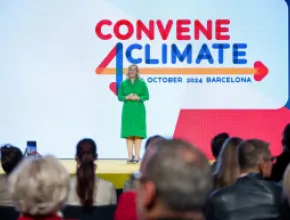When it comes to creating a sustainable meeting, an almost reflexive reaction many meeting planners have is that the effort will result in added cost. It’s a perception that has stubbornly countered the green meetings movement since its beginnings.
“It’s refused to go away,” says Nancy J. Zavada, founder and president of leading sustainable meetings and CSR company MeetGreen, and who co-founded the Green Meeting Industry Council in 2003. “It’s in the top three [objections to sustainable meetings]. It’s always there, along with how much work it may take and the possibility of attendee pushback.”
But no matter how much Zavada recites the gospel of green meetings cost-containment—or even savings—the opportunity to re-emphasize that an organization doesn’t have to blow their meeting budget to make strides toward sustainability is always a worthwhile endeavor for this industry leader who pens the pithy blog “Pretentious Musings of a Meet Green Martyr.”
“I tell them that it can be cost-neutral, and can be cost-saving depending on the decisions they make,” she explains. “There are decisions that will cost them more and decisions that will cost them less, so they can pick and choose.”
To help planners make that right decision, and actually take their sustainability meetings costs out of the red and into the black, we asked Zavada, who recently published Meet Better—167 Easy Ways to Make Your Events More Environmentally and Socially Responsible with fellow sustainable meetings experts Mariela McIlwraith and Shawna McKinley, to provide a few easy-to-implement tips that will actually result in budget savings rather than draining the coffers.
- Set your water free! Eliminating bottled water in favor of dispensers or pitchers on a conference or dining table is probably the most obvious money-saving strategy. “This is a no-brainer,” Zavada says. “I can’t believe anyone in the world is still offering bottled water.”
- Bag the bags. Eliminating the use of bags for conference materials—especially when there is no bag sponsor—is a cost-containment strategy that saves money in a variety of ways. “Conference bags—really?” Zavada sniffs. “What are we carrying around in those conference bags? Everyone has a cell phone or tablet now. You have the bag, you have the shipping, and then you have to have people that stuff the bags; there’s a lot of costs that people don’t think about—there could be a whole day of packing for larger events,” Zavada continues, adding that sponsorship opportunities can be tapped for conference apps, which have really become de rigueur, anyway.
- Vegetables are your friends. Although you may need to explain the decision to your attendees that can’t imagine a lunch plate without a serving of meat, with a little creativity and dexterity planners can save on their F&B budget by eliminating animal products when possible, if only for a meal or two. “You can serve free-range chicken and your caterer may want to charge you more, but you can also serve a vegetarian meal that caterers will charge you less for,” Zavada says. “Say you’re doing a ‘Meatless Monday’ type of promotion; then they don’t complain. They usually don’t complain, anyway, if the vegetarian meal is a good one, and it always saves you money. If you have a thousand-person conference and you have a ‘Meatless Monday’ lunch, that saves you 2.83 metric tons of carbon, which is the equivalent of 72 tree seedlings growing for 10 years. You can put that on a card on the table.” Indeed, explaining the “Meatless Monday” concept via informational cards on the table or through other communication channels will help paint the decision in a feel-good light.
- Take your company public—as in public transportation. Major metros often offer efficient public transportation options that can get attendees from the airport to the meeting site relatively hassle-free. Zavada recommends arranging for “Transit Ambassadors” to be stationed at the airport to explain how to use public transport to get to the event’s hotels or the convention center. “In a city like San Francisco, if you have a big enough group and have a transit ambassador at the airport to help them on transit—such as BART, in that case—that saves them $50 when compared to taking a taxi.” It also cuts emissions from taxis and shuttle buses.
- Rein in the organic options. Sure, going organic is all the rage—and really is a more nutritious, delicious and sustainable way when it comes to your food service—but it can be costly. “If you want to go organic, you don’t have to go 100 percent,” Zavada suggests. “Negotiate with your caterer up front for a 30 percent organic component, at no extra charge, during the contracting phase.”







